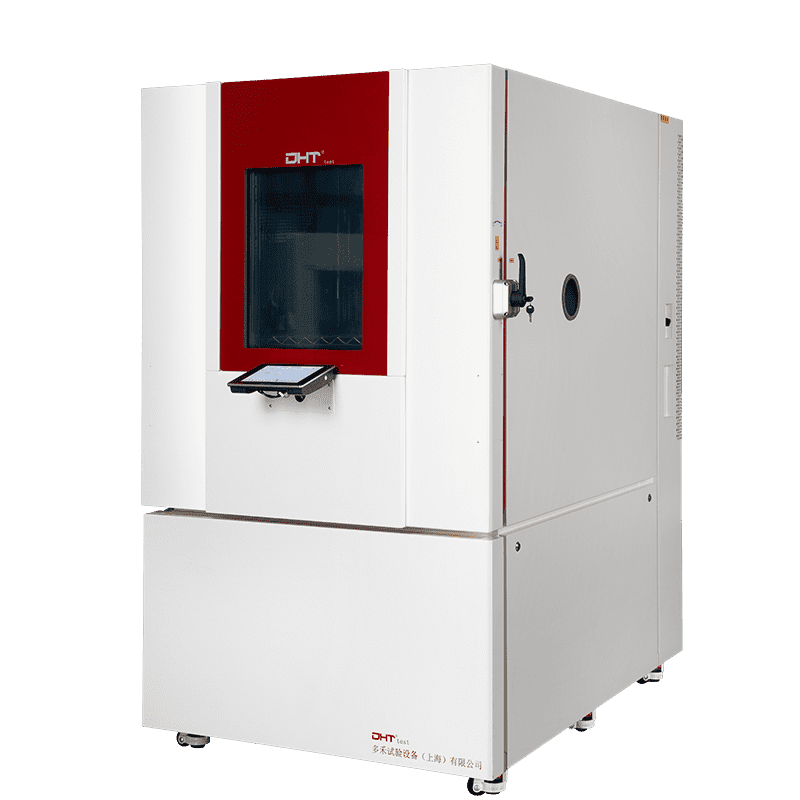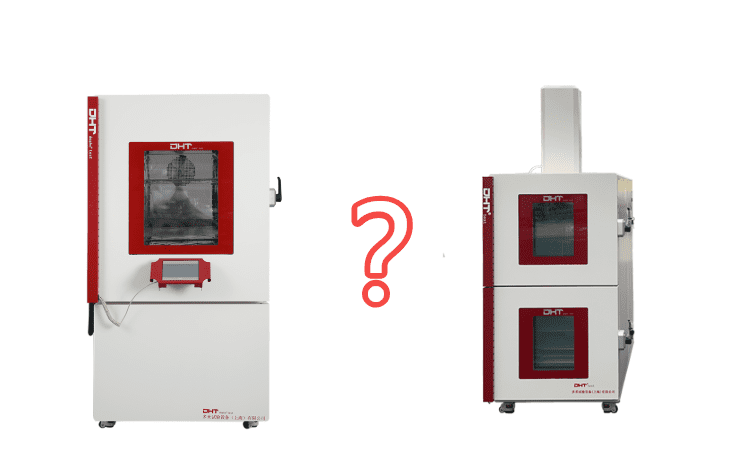Écrit par Robin
Ingénieur principal, Doaho Test (DHT®)
Dans les opérations quotidiennes de laboratoire, il y a une question que les ingénieurs et les techniciens se posent souvent : "Avons-nous choisi le bon équipement de test ?"
Cela devient particulièrement pertinent lorsque votre projet implique de simuler des changements de température ou de valider la stabilité des produits dans des conditions extrêmes. Dans de tels cas, deux types d'équipement apparaissent généralement dans la liste technique : Chambres à taux de changement rapide et Chambres de choc thermique.
Mais qu'est-ce qui les différencie exactement ? Comment déterminer lequel est le mieux adapté à vos besoins spécifiques de test ?
Plutôt que de plonger dans le jargon, adoptons une approche pratique - basée sur des applications réelles - pour explorer les différences fondamentales entre ces deux types de chambres et quand utiliser chacune.
Premières choses à faire : Elles peuvent sembler similaires, mais fonctionnellement elles sont très différentes.
Pour de nombreux utilisateurs débutants, les chambres à taux de changement rapide et les chambres à choc thermique peuvent sembler interchangeables. Après tout, elles simulent toutes les deux des changements de température, n'est-ce pas ?
Pas tout à fait.
-
Chambres à taux de changement rapide sont comme des contrôleurs de climat de précision. Elles ajustent la température à un taux linéaire programmable - par exemple, refroidissement de 25°C à -40°C puis réchauffement jusqu'à 150°C - le tout de manière contrôlée et stable. Les taux de changement typiques vont de 5°C/min à 15°C/min ou plus.
-
Chambres de choc thermique, en revanche, sont les accros de l'adrénaline des tests environnementaux. Plutôt que de changer la température progressivement, elles "jettent" instantanément les échantillons entre des zones extrêmement chaudes et froides. Le différentiel de température peut dépasser 150°C, avec des temps de transfert généralement inférieurs à 10 secondes.
En bref : une simule des transitions graduelles, l'autre délivre des extrêmes instantanés - et c'est la différence la plus fondamentale.
Alors, lequel devriez-vous choisir ? Tout dépend de ce que vous testez.
Chaque expert en test environnemental sait ceci : l'appareil lui-même n'est qu'un outil - la vraie question est, qu'est-ce que vous essayez exactement de tester ?
Lorsque vous êtes clair sur vos objectifs de test, la décision devient beaucoup plus facile.
Scénario 1 : Besoin de réaliser des tests de fiabilité sur la durée ou des cycles thermiques ? Choisissez les chambres à taux de changement rapide.
Les produits comme les ECU automobiles ou les équipements de communication extérieure subissent souvent des changements de température répétés et graduels - brûlant chaud pendant la journée, gelant la nuit. Ces fluctuations réelles sont mieux reproduites en utilisant des chambres à taux de changement rapide.
Les profils de température en montée linéaire ou contrôlés par étapes les rendent idéales pour les tests de fiabilité de longue durée et les validations de cycles thermiques. Vous pouvez contrôler la vitesse, définir votre programme et obtenir des résultats précis et reproductibles adaptés aux besoins de R&D et de vérification qualité.
Scénario 2 : Besoin de tester Expansion thermique, fissuration ou intégrité structurelle ? Les chambres à choc thermique sont indispensables.
Lorsqu'il s'agit de matériaux aérospatiaux, d'emballages semi-conducteurs ou de condensateurs céramiques, les changements de température abrupts peuvent causer des stress importants - expansion, contraction, voire fissuration ou délaminage.
Si votre objectif est de simuler des changements environnementaux soudains et extrêmes qui peuvent conduire à une défaillance instantanée, les chambres à choc thermique sont incontournables. Seules elles peuvent reproduire avec précision ces transitions dramatiques auxquelles les matériaux sont confrontés dans le monde réel.
Ce que la plupart des utilisateurs négligent : 3 différences clés qui comptent.
En travaillant avec des milliers de clients, nous avons remarqué quelques différences souvent négligées qui peuvent avoir un impact significatif sur votre choix :
1. Coût et Maintenance
Les chambres à choc thermique - en particulier les systèmes à trois zones - ont des structures mécaniques plus complexes et nécessitent des zones chaudes/froides indépendantes avec des mécanismes de transport rapides. Cela entraîne des coûts initiaux plus élevés et un entretien plus intensif.
Les chambres à taux de changement rapide, en revanche, sont structurellement plus simples et plus faciles à entretenir - idéales pour les laboratoires effectuant des volumes de test élevés tout en gardant le contrôle des coûts de fonctionnement à long terme.
2. Consommation d'énergie et stabilité
Les tests de choc thermique nécessitent des systèmes de chauffage et de refroidissement de haute puissance pour réaliser des changements instantanés, entraînant une consommation d'énergie substantielle.
Les chambres à taux de changement rapide, bien que toujours haute performance, peuvent être configurées pour optimiser l'efficacité en utilisant des taux de rampe programmables et des stratégies d'isolation - ce qui les rend une solution plus écologique et plus respectueuse de l'énergie.
3. Simulation réaliste vs stress extrême
Les chambres à taux de changement rapide excellent à imiter les fluctuations environnementales réelles, grâce à des courbes de température personnalisables.
Les chambres à choc thermique, en revanche, se concentrent davantage sur le fait de pousser les composants à leurs limites, révélant des faiblesses structurelles - mais peuvent ne pas toujours refléter les conditions de fonctionnement quotidiennes typiques.
Dernières réflexions : Bien choisir, c'est tester intelligemment.
De nombreux clients demandent : "Lequel est meilleur ?"
La vérité est qu'il n'y a pas de solution "meilleure" unique - seulement celle qui convient le mieux à vos objectifs de test.
Si votre priorité est la précision, la stabilité et la fiabilité à long terme sous des changements contrôlés, une chambre à taux de changement rapide est votre choix de prédilection. Si vous testez la survivabilité sous stress thermique extrême, rien ne vaut une chambre à choc thermique.
Chaque test de fiabilité est un engagement envers la qualité. Choisir la bonne chambre vous donne plus de confiance, plus de contrôle et plus d'assurance avant que votre produit n'arrive sur le marché.
Pourquoi DHT®
Chez DHT, nous avons passé plus d'une décennie à concevoir des chambres à taux de changement rapide haute performance, des chambres à choc thermique et des solutions de test de fiabilité personnalisées. Avec plus de 20 000 clients dans le monde entier - dans des secteurs tels que l'automobile, l'aérospatial, l'électronique et la recherche - nous comprenons ce qu'il faut pour répondre à vos besoins de test avec précision et confiance.
À la recherche de l'équipement de test environnemental idéal pour votre application ? Parlez à notre équipe d'experts dès aujourd'hui.
DHT® - Que votre test soit le début de la fiabilité de votre produit.
Les gens demandent aussi
Quelle est la différence entre une chambre à taux de changement rapide et une chambre de choc thermique?
Les chambres à taux de changement rapide simulent des changements de température graduels à des vitesses programmables (par exemple, 5°C/min à 15°C/min), idéales pour les tests de fiabilité à long terme et les tests de cycles thermiques.
Les chambres à choc thermique exposent les échantillons à des changements de température extrêmes instantanés, généralement plus de 150°C en moins de 10 secondes, pour tester la résistance des matériaux, la fissuration ou les risques de défaillance subite.
Quand devrais-je choisir une chambre à taux de changement rapide au lieu d'une chambre de choc thermique ?
Choisissez une chambre à taux de changement rapide lorsque vous avez besoin :
Tests de fiabilité de longue durée
Validation R&D avec des courbes de température programmables
Simulations de cycles réels jour-nuit ou saisonniers
Quelles sont les différences de coût et d'entretien entre les deux types de chambres ?
Les chambres à choc thermique ont :
Investissement initial plus élevé
Structure plus complexe (zones chaudes/froides, panier de transfert)
Consommation d'énergie et exigences de maintenance plus élevées
Les chambres à taux de changement rapide sont :
Plus faciles à entretenir
Plus économes en énergie
Mieux adaptées aux laboratoires de test à haute fréquence avec contrôle budgétaire


